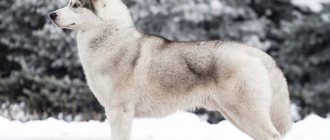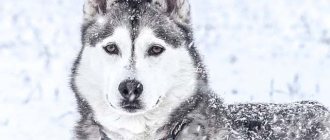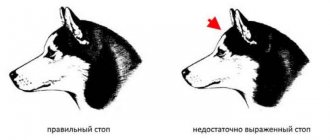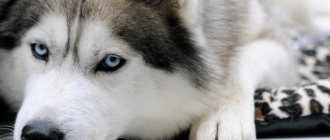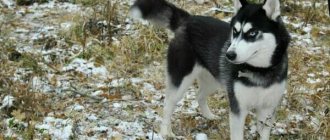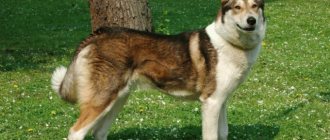Many people who are not very well versed in dog breeding confuse huskies and huskies and do not know what the difference is between them.
Indeed, there are many similarities between these two breeds, however, they have no less differences.
Moreover, this applies not only to the exterior, but also to the characteristics of the psyche, character, temperament and even purpose.
All this must be taken into account when keeping, raising and training these dogs, and therefore, anyone who is thinking about purchasing a husky or husky needs to study the similarities and differences of these two dogs before purchasing a puppy.
This will not only help provide the pet with the most suitable living conditions, but will also save their owners from disappointment in the future.
Brief information about Husky
Photo and description
The dog is of medium height (approximately from 50 to 60 cm at the withers, weight is about 15-28 kg), compact, but at the same time harmonious build.
The body is slightly stretched and exceeds the height at the withers by no more than 2-3 cm; the shape of the head from above resembles a triangle, slightly tapering towards the muzzle. The stop is well defined, but not sharp.
The length of the muzzle is approximately equal to the length of the cranial part of the head.
The ears are erect, triangular, of medium size, set quite close to each other.
The eyes are almond-shaped, slightly slanted. Their color can be blue, brown, amber, olive. In addition, different eye colors .
IMPORTANT!
The nose, as well as the pigmentation of the lips and rims of the eyelids, depending on the color, can be black or brownish.
The neck is of medium length, the chest is deep and powerful, but not too voluminous. The forelimbs are moderately wide, even and parallel. The hind legs are muscular, with well-defined angulations of the hock joints. The tail is similar to a fox's, in a calm state it is lowered downwards, but when alert, it is carried in the form of a sickle over the back.
The coat is not too long, two-layered, while the undercoat is thick and soft, and the coarser hair is quite smooth and adjacent to the body. The color can be almost any, although the most typical colors for huskies are grey-white, black-and-white, brown-white and reddish-white.
Advantages and disadvantages
Pros:
- Intelligence and intelligence.
- Ability to make decisions independently when necessary.
- Lack of aggression towards humans.
- Love for children and playful disposition.
- Loyalty to the owner.
- Endurance and unpretentiousness.
- Easy hair care.
- They make excellent sled or sport dogs.
Minuses:
- Not suitable as guard dogs.
- Tendency to dig up the earth.
- Sometimes they are headstrong and stubborn.
- They often howl.
- They can be aggressive towards smaller animals.
- They need a lot of physical activity and long walks.
- Out of boredom, they can start to damage things in the house.
Character
Lively and friendly towards people. Huskies, unless serious mistakes were made during their upbringing , are never aggressive towards humans and are not inclined to bite.
Friendliness towards strangers and lack of territorial instinct make these dogs poor guards and this must be taken into account by people thinking about purchasing such a pet.
Huskies have an innate hunting instinct, but they will not make hunters either. These dogs hunt for game only for their own food and will never give it up to their owner of their own free will.
These are independent, independent, and sometimes stubborn and willful animals, prone to running away and wandering.
In addition, huskies love to dig up the ground and, out of boredom, can chew furniture, tear off wallpaper, or howl like wolves.
However, when keeping these dogs in the house, you need to take into account that most of the bad habits of a husky are easy to remove or simply prevent them from appearing in your pet. This is achieved through early socialization and proper education and training.
In addition, as noted above, huskies act out mainly from boredom and idleness, and therefore, if you provide the dog with sufficient mental and physical stress, it simply will not have time for mischief.
Dimensions, weight. Appearance
According to the standards of the Husky dog breed, the height at the withers for males is 53–56 cm, for females – 51–56 cm. Weight for males varies from 23 to 27 kg, for females – from 16 to 23 kg. Huskies have a lean constitution, proportional build, developed muscles and strong bones. The head is small, the muzzle is elongated, the forehead is pronounced, the ears are triangular and erect, the eyes are medium-sized, the distinctive feature is the iris of blue color, but it can be brown and red. The neck is strong, the chest is not very wide, deep, the chest is rounded. The back is straight. The legs are strong and muscular. The tail is held in a sickle when moving.
The coat is developed, dense, thick, with developed undercoat. Coat color: all shades of gray, white, silver, wolf, black and white, piebald, sable, as well as copper and red.
A little about likes
Photo and description
Laikas are not representatives of one breed, but a breed group that unites several dogs similar in origin, appearance and purpose.
Most huskies are hunting dogs, although many are also suitable for other work. For example, the Nenets Laika is excellent at herding deer, and the Yakut Laika can be used not only for hunting, but also as a sled dog.
In terms of their physique and coat characteristics, huskies are very close to dogs of the so-called wild or wolf type. Moreover, representatives of different breeds of huskies differ from each other, first of all, in the structure of the head and muzzle.
All of them are characterized by a strong, but not squat, build, as well as pointed, erect ears and a tail curled into a full or incomplete ring.
The coat of these dogs is not too long, but at the same time very dense and thick, with an abundant, moderately soft undercoat.
Laikas can come in a variety of colors, but the most typical coat colors are wolf, gray or black, often accompanied by white markings of various shapes and sizes.
Advantages and disadvantages
Pros:
- Excellent hunting dogs, suitable for tracking a variety of game.
- Hardy and unpretentious.
- They are distinguished by good health and, often, long life expectancy.
- Balanced and calm character.
- Devotion and obedience.
- Goodwill towards people, which, however, does not prevent huskies from being good guards.
- Undemanding to nutrition.
Minuses:
- Not suitable for keeping in an apartment.
- Hunting huskies may be at risk of contracting a serious infection in the forest or field.
- Very strong shedding.
- Despite their devotion, they can become disobedient when chasing game.
Character
Laika is quite independent and proud; she recognizes only partnerships with her owner and does not tolerate either excessive familiarity or rudeness in handling herself. This is a very smart and quick-witted animal, which, depending on the current situation, can make its own decisions during the hunt.
Laikas are friendly towards people and make good companions for children, especially since most of these dogs have a cheerful and playful disposition. Laikas are distrustful of strangers, but without increased aggression.
NOTE!
These dogs have an innate viciousness and ruthlessness towards prey, therefore, huskies need early socialization, without which they can be dangerous to pets smaller than themselves.
Differences in metabolism
Huskies have a special metabolism that is more characteristic of wolves than dogs. Proof of this is the absence of the odor characteristic of dogs. They can speed up or slow down your metabolism depending on the situation. This allows dogs to go without food for a long time and at the same time withstand heavy physical exertion.
Similar article: Specifics of keeping a husky in an apartment
Thanks to their metabolism, they are less susceptible to disease and live longer than others. But at the same time, this feature forces the dog to spend a lot of time on the move. Without this, she may develop diseases and inappropriate behavior.
Siberian huskies also have a good metabolism. They are not picky eaters and can digest even the heaviest food. Due to the characteristics of their body, they require significantly less food than other individuals of this configuration.
What you should pay attention to?
When buying a puppy of one of the breeds, you need to have a good understanding of the purpose for which you need the dog. Neither one nor the other will be a plush toy. They need a lot of space, food and long walks. If you intend to keep a dog in an apartment, then it is better to choose a husky. In addition, the Husky does not do well in hot rooms, so people living in the southern regions should not adopt it.
In addition, make sure that there is no “fake”; it is more difficult to find a common language with such dogs. This can be determined by the absence of characteristic spots on the body.
Main differences
The main characteristics by which huskies and huskies differ:
- Huskies have a denser and more muscular build, while huskies are taller and have lighter bones.
- Huskies' ears are rounded at the ends, while huskies' ears are pointed.
- Husky paws are wider, stronger and more powerful than those of huskies.
- Laikas have rounder eyes, while Huskies have almond-shaped eyes. In addition, the eye color of a husky can only be dark, and not blue or heterochromic, like that of a husky.
- The look of a husky expresses curiosity and energy, while the look of huskies shows balance, attentiveness and some wariness.
- The fur of huskies is coarser in texture than that of huskies.
- The husky's tail is held downwards or in the shape of a sickle, while in huskies it is curled into a complete or incomplete ring.
- Huskies are larger in size: their height reaches 60 cm and their weight is 28 kg, while huskies are smaller and weigh more than 23 kg.
Huskies are larger and heavier than huskies, they have stronger bones and better developed muscles. Laikas look taller and lighter-boned compared to them.
Husky ears are rounded at the ends, while husky ears are sharper, and eyes can be not only brown, but also blue and even different colors. Laikas can be exceptionally dark-eyed, and their gaze is calmer and more serious than that of a husky.
The main external difference between the husky and the husky is that the husky’s tail is wrapped in a ring, while the husky’s tail resembles a fox’s and hangs down when at rest.
Results
Summarizing the difference between a husky and a husky, we can draw the following conclusions:
- Purpose
It must be remembered that initially, the purpose of these two breeds of dogs is completely different, therefore, huskies are sled dogs, have great endurance and easily adapt to various conditions, and huskies are hunting companions who perfectly track down game and can give signals to the hunter about the hunted animal . Also, huskies can become excellent home guards.
- Huskies are a one-of-a-kind breed, and huskies have a whole list of subspecies.
- Huskies, unlike huskies, can control their metabolism, which allows them to easily endure various loads and living conditions.
- Laikas, unlike huskies, can bark in different ways, thereby communicating with their owner during the hunt.
- Laikas, like huskies, can work as sled dogs, but only for short distances, since their stamina is not sufficient.
- Huskies can turn on their egoism during a hunt and regard the prey as their own.
- The husky's tail does not fall over its back, like that of huskies.
- Husky fur is odorless, while huskies can have a specific “dog” smell.
- Huskies howl more often than bark.
- Huskies have thicker fur, with a dense undercoat, while huskies have long fur.
Common features
The main external similarity of these dogs is their erect ears, as well as a wedge-shaped head and a slightly pointed muzzle.
The coat of a husky and a husky also has a similar structure - it is very dense and dense, consisting of a soft undercoat and a coarser and tougher awn.
Both huskies and huskies look like strong and hardy animals, and they also both have some external resemblance to wolves.
Who is easier to maintain and care for?
Despite the popular belief that Huskies are not easy to keep indoors, caring for these dogs is not difficult. Representatives of this breed require infrequent brushing, occasional bathing as needed, and eye, ear, and nail care. Only during shedding do they need to be brushed daily.
In huskies, shedding is more pronounced than even in huskies, which makes caring for them somewhat more difficult. In addition, these dogs' fur has a coarser texture, making it more difficult to remove from clothing, carpets and upholstered furniture.
IMPORTANT!
When caring for and maintaining hunting huskies, you should never neglect treating your pet for parasites and timely vaccinations, since these dogs are prone to infectious diseases transmitted from other animals or carried by external parasites.
Attitude towards children and pets
Both huskies and many huskies have a cheerful and playful disposition and are good with children.
However, some breeds of huskies are not recommended as pets for families with children, as their nature is too stern and independent for these dogs to calmly deal with children who bother them or tease them.
As for the attitude of these dogs towards other domestic animals, huskies, who do not have innate malice towards the beast, are more tolerant of them than huskies.
What is the difference between HUSKA and LAIKA?
To an inexperienced person, huskies and huskies seem very similar. First of all, because at first glance it is clear that these are northern dogs. In Russia, they are more accustomed to huskies, which is why they sometimes call huskies, which appeared quite recently, that way. However, these dogs are not even relatives and there are a number of significant differences between them.
Huskies are an independent breed of dog, and huskies are a whole group consisting of several breeds that differ from each other.
First of all, the purposes of huskies and huskies are different. Huskies are sled dogs bred to run in sleds, carrying loads and people across endless snowy expanses. An amazing feature of the husky is the ability to control the metabolism of its body. They know how to slow down or speed up their metabolism depending on the circumstances. This skill allows dogs to have unprecedented endurance. For example, huskies are capable of running in a heavy sled through the snow all day long without stopping. According to legend, in 1925 in the United States, a husky team saved an entire city from death by quickly delivering diphtheria vaccine hundreds of miles away. A statue of the team leader Balto stands in New York at the entrance to Central Park.
However, huskies are not capable of hunting with humans, since any caught game is regarded as their own prey. In addition, huskies originally lived in packs. Only a certain Leader had contact with the person. The man gave commands to the Leader, who controlled the rest of the dogs in the sled. It is interesting that the Leader had the right to his opinion in choosing the path. This was due to the fact that a person might not see a crack in the ice, which would cost everyone their lives. Most likely, this gave rise to the independence of the husky and the priority of its own interests over the interests of the owner in everyday life, which can be changed with proper upbringing and competent training. In addition, the husky most likely will not protect its owner or his property, since individuals aggressive towards humans have been destroyed from generation to generation.
Laikas are the most ancient hunting dogs. They accompanied hunters in the northern forest zones of Europe and Asia and helped people get food. They practically do not need to be trained, their hunting instinct is so strong. Laikas drive hidden feathered game out of the thickets, bring downed birds to the hunter, and drive wood grouse and black grouse into trees. In the trees, the dog detects sable, squirrel and marten, in burrows - weasel, ferret, raccoon dog, and finds the under-ice paths of otters and minks. The husky also stops and detains such animals as lynx, bear, wolverine, elk, and wild boar.
Laikas received their Russian name due to the special art of barking. During the hunt, the husky silently follows the trail or searches for the animal, and only when it sees it, it gives a barking signal and either pursues the prey or forces it to stop until the hunter arrives. Moreover, the voice of the husky varies depending on the game. If a sable or marten is detected, the dog barks especially viciously. If there is a squirrel in a tree, the barking is persistent and even. Since the capercaillie is very careful not to scare it away, the dog barks in a low voice, without coming close. If the husky has caught up with a deer or elk, it stops in front of its muzzle and barks kindly in order to hold the ungulate, but not to frighten it. Hunters often train their dogs to bark at only one animal they need.
Some huskies are also used in harnesses, but for short distances, since their driving characteristics are rather modest.
Huskies can be easily distinguished from huskies by the fact that they hardly bark, but prefer to howl in a peculiar way.
The breed standardization documents indicate that the country of origin of the husky is the USA. However, there is another version of the appearance of this breed. Russian researchers prove that the Siberian husky is the direct ancestor of the polar dog, which was bred by the Chukchi. After the October Revolution, these dogs were banned from breeding by the Soviet authorities. Several flocks were purchased and taken to the USA, where their breeding continued. 70 years later, American huskies were smuggled into the former USSR from Finland. The name Husky itself is a corruption of "Eski", meaning "Eskimo".
Laikas are thought to have evolved from a large, wolf-shaped dog fossil and a smaller, jackal-shaped one.
Huskies also differ from huskies in appearance. Husky males grow up to 60 cm at the withers and weigh about 28 kg. The shape of their head is quite similar to that of a wolf. Almond-shaped eyes can be brown, but blue-eyed huskies are especially popular among dog breeders. Huskies have softer fur. The color of a husky can be very different - from completely snow-white to black. On the head there is often a remarkable difference of this breed - a pattern in the form of glasses, an asterisk, a clover leaf, stripes, grooves, strokes, a heart and others. Unlike the husky, the husky holds its tail without letting it fall over its back. Another feature of the husky is the absence of the characteristic dog smell and wider paw pads, which allows them to move through deep snow.
Since several breeds belong to the group of huskies, they can differ quite greatly in appearance. The largest is the East Siberian Laika. The height at the withers of males reaches 64 cm. The weight of huskies reaches up to 23 kilograms. Laikas come in black, black and piebald, red, gray and brown in all shades.
The West Siberian Laika reaches a height of 60 cm and can be of all colors, both piebald and solid, except brown. This is the calmest and most balanced among the huskies, it successfully hunts ducks and large animals, and follows a cold trail well. The Karelian-Finnish husky is distinguished by a very lively, active temperament, which allows them to effectively hunt squirrels and game birds, but makes it difficult to learn to work on the cold trail of an animal. There are also Russian-European, Finnish, Hantei, Mansi and other breeds of huskies.
All huskies, unlike huskies, have a characteristic smell, longer hair and a tail in a tight ring laid on the back.
Conclusions:
- Huskies and huskies are distinguished by their purpose. First of all, huskies are sled dogs and therefore more resilient, while huskies are hunting dogs and are well suited as guard dogs.
- Unlike huskies, which are an independent breed, huskies are a whole group of breeds.
- A distinctive feature of the Husky is that it can control its body's metabolism.
- A distinctive feature of huskies is that they use different techniques and tactics to bark at different prey, depending on its size and behavior.
- Unlike huskies, huskies usually do not share their prey and are a more freedom-loving breed, which can be changed with proper education and training.
- Some huskies, like huskies, can be used in harnesses, but not for long distances.
- Huskies are very different from huskies in appearance. The main differences include eye color and a characteristic pattern in the form of glasses, stars, cloverleaf, stripes, grooves, strokes, hearts and others. The husky holds his tail without letting it fall on his back. Another feature of the husky is the absence of a characteristic dog smell.
- Laikas are slimmer, unlike huskies, which are tightly built. Husky paw pads are wider.
- Usually huskies howl and huskies bark.
Who is more picky about feeding?
Both dogs can eat both home-cooked and commercially prepared food and are not particularly picky about what they feed.
However, you need to take into account that huskies are more prone to overeating, and therefore it is necessary to take a more responsible approach to their diet and not supplement the pet between feedings.
Comparison by other criteria
Aggression towards people
Uncharacteristic of either huskies or huskies.
But at the same time, the latter can treat strangers with distrust and can even be good guards, while huskies are friendly towards all people and because of this are completely unsuitable for protection.
Activity and exercise
Both dogs require a lot of exercise and are energetic and active. There are almost no differences in this matter.
Lifespan
The difference here is that huskies live on average 12-14 years, while the life expectancy of huskies can reach 17 years.
Origin and habits
How to distinguish a husky from a husky?
Laika is one of the first dogs to become friends with humans. Presumably, its ancestors were the jackal and the wolf-like dog, which was found only in northern Europe.
Laika and husky have a very developed hunting instinct. The Siberian Laika requires virtually no training. Its peculiarity is that when tracking prey, it is silent, and as soon as it finds it, it begins to bark. At the same time, the nature of the barking changes depending on the prey. This was the reason for this name. Despite their passion for hunting, huskies are good watchmen and can even be shepherds. They can also be kept in an apartment.
Huskies have a very large number of varieties, which today are classified as a separate breed. Therefore, the word “husky” refers to a Siberian breed. There is no consensus regarding its origin. It has similarities with both the Alaskan namul and the Chukchi sled dog. It is impossible to determine exactly due to the fact that the latter was destroyed at the beginning of the last century.
The name Husky comes from the American word “Eski,” meaning “Eskimo.” They also love hunting, like huskies, but they never share their prey. Unlike other breeds, they do not perceive humans as masters. They do not have such obedience to commands. For them, a person is a leader. The breed has a lot in common with wolves. A special feature is the absence of barking. Most often they prefer howls.
Similar article: All the most interesting things about the Alaskan Klee Kai or Mini Husky
Huskies should not be used as a guard dog. It is also worth noting that if individuals of this breed are not actively walked for a long time, they become aggressive and can destroy the entire house. Therefore, it is not advisable to keep them in an apartment. The husky has almost no similarities with a wolf and you can keep them in an apartment.
Price difference
The cost of husky puppies with documents starts from 15 thousand.
A small husky can be purchased for 5-10 thousand, however, if we are talking about purchasing a dog from parents who have shown excellent results in hunting, then its cost may be slightly higher.
Who should you choose?
When choosing who to buy, you must, first of all, proceed from the purpose of the future pet. If you need a hunting dog, then you need to buy a husky, but if you need a dog for sledding, then you should buy a husky.
Conditions of detention are also of great importance. Laikas are not suitable for living in an apartment, while huskies tolerate indoor living quite well, provided they receive sufficient physical and mental exercise.
NOTE!
For families with small children, a husky is better suited, since not all huskies can be kind to kids, but at the same time they will make wonderful friends for older children.
